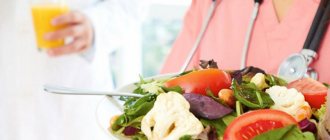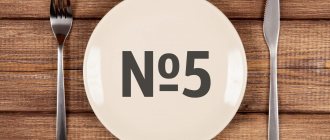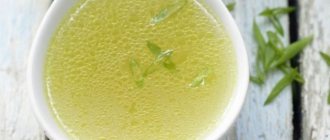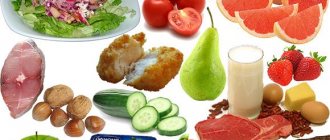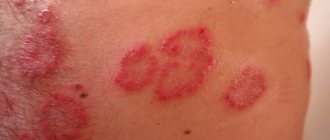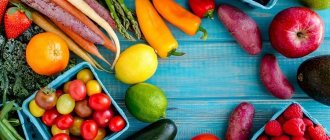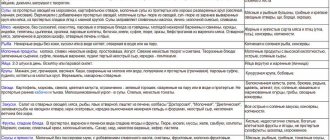The development and progression of heart disease is directly related to atherosclerotic vascular lesions. The main risk factors: hyperlipidemia caused by diet, hypertension, alcohol consumption, smoking.
A low-cholesterol diet allows you to level out the imbalance of lipoproteins in the blood. What are its features, rules, sample menu for the week - read on.
The essence of the hypocholesterol diet
In fact, cholesterol is an important product that is produced in the liver and serves many vital functions of the body. But increasing its level can lead to adverse consequences: atherosclerotic plaques appear, which are deposited in the blood vessels, thereby causing blockage of the arteries. And that, in turn, already affects the appearance of other terrible cardiovascular diseases.
Content:
- The essence of the hypocholesterol diet
- Basic rules of the hypocholesterol diet
- Prohibited Products
- Authorized Products
- Menu for a week with a hypocholesterolemic diet
- Recipes for a hypocholesterol diet
- Contraindications and harms of a hypocholesterol diet
- Results of a hypocholesterol diet
- conclusions
Lately, the problem of high cholesterol has been a concern for many people, as modern life makes its own adjustments to people’s diet and lifestyle. Doctors attribute this primarily to the increased content of “bad” fats in our diet. But it’s true, not many people are able to pass by such delicious-smelling fast foods and fast food chains. And also with regular consumption of alcoholic beverages, smoking, excess weight, hereditary factors and, of course, a sedentary lifestyle.
At its core, the hypocholesterol diet is aimed at reducing the consumption of foods that contain high levels of cholesterol. There are immutable rules of this diet, the observance of which will not only normalize cholesterol levels in the body, but also lose excess weight and radically change your lifestyle, thereby helping to improve your overall well-being.
Bottom line
Once you know what a low-cholesterol diet is, you see that there is no need to completely exclude certain foods from your diet. But it is important to ensure that the maximum part of the menu consists of suitable food, and that unsuitable food is included only in exceptional cases.
Healthy eating has a significant impact on health. Regardless of whether a person suffers from excess weight or high cholesterol, the best assistant in combating the problem is a varied, balanced diet.
IMPORTANT! Informational article! Before use, you should consult a specialist.
Basic rules of the hypocholesterol diet
In order for the results of a hypocholesterol diet to be pleasing, it is necessary to follow the basic rules, any violation of which will only worsen the general condition and will minimize all efforts.
Here is a list of these recommendations:
- avoidance of harmful animal fats, or reducing their consumption to a minimum;
- mandatory consumption of fish, except fried fish, about twice a week;
- replace fatty meat with more dietary meat: turkey, chicken, rabbit or veal;
- Alcoholic drinks are strictly prohibited;
- excluding flour and sweet foods from the diet, or reducing their consumption to a minimum;
- use of vegetable dishes, fruits and low-fat dairy products in the daily menu;
- using stewed or boiled food instead of fried;
- a categorical ban on the use of mayonnaise, replacing it with lemon juice and spices;
- Cool meat broth before use and skim off the top layer of fat;
- It is advisable to cook the bird without fat and skin.
Reviews
Nadezhda, 40 years old, Orel: over the past 7 years, I have suffered from high blood pressure. The doctor recommended that I get tested for cholesterol. It turned out that my cholesterol was higher than 6.0 mmol/l.
After going through the hypocholesterol diet, my blood pressure decreased, and my cholesterol became 5.5 mmol/l. And another positive aspect of this diet is that I lost 4 kilograms.
Anatoly, 46 years old, Tula: over the past 4 years I have gained a lot of extra pounds from poor nutrition. My blood pressure began to rise and heart problems began. After a cholesterol test, which was 7.0 mmol/l, the doctor prescribed me a cholesterol-lowering diet.
The first week I didn’t notice any results, but from the second week I began to notice that I was losing pounds. After a month-long diet, I was able to bring my cholesterol closer to normal and lose 6 kilograms of excess weight.
Prohibited Products
Prohibited foods on a hypocholesterol diet include:
- various types of sausages, sausages, small sausages, smoked meats;
- fatty meats, offal, as well as duck or goose meat;
- egg yolks, heavy cream, sour cream and cottage cheese, condensed milk and processed cheese;
- butter, coconut, palm oil, lard, animal fats and hard margarine;
- canned fish and other preserves;
- various nuts (peanuts, pistachios, hazelnuts), chips, candied fruits and French fries;
- baked goods, biscuits, rolls, cakes and other confectionery products;
- all types of sugar, chocolate, sweets, as well as marshmallows and marmalade;
- alcohol, strong coffee with cream and cocoa.
Contraindications

Since the diet involves a significant restriction of sodium intake, as well as an increase in potassium and magnesium intake, it has a number of contraindications. Doctors do not recommend following diet No. 10 for pregnant women, lactating mothers and young children.
Also, this diet plan is not suitable for people who have serious kidney problems or suffer from cancer.
Authorized Products
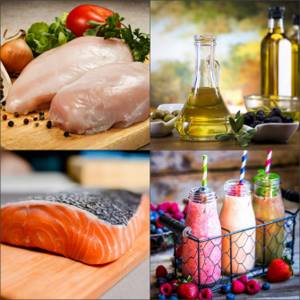
Allowed foods for high cholesterol include:
- all lean meats (veal, chicken, turkey, rabbit, as well as wild animal meat);
- You can only eat egg whites no more than 2 times a week;
- low-fat milk and fermented milk products, cheeses with no more than 20 percent fat content;
- vegetable oils (sunflower, corn, olive, soybean), soft margarine;
- sea fish (sardine, salmon, tuna, flounder, mackerel, cod and herring), as well as caviar and seafood about twice a week;
- various fresh or frozen vegetables, legumes, dried fruits and corn;
- whole grain bread, durum wheat pasta, oatmeal and oatmeal cookies, brown rice, low-fat puddings and sorbet;
- popsicles and frozen juice, various jellies and smoothies;
- sugar-free juices, various teas, weak coffee and mineral water.
Folk remedies in the fight against cholesterol
You can combat high levels of unhealthy fats not only with diets and healthy foods, but also with the use of folk remedies. Be sure to remember that the use of any prescriptions should occur after consultation with your doctor. Allergic reactions may occur due to individual intolerance to the components. We offer several proven ways to reduce cholesterol:
Dill seed tincture
Ingredients:
- half a glass of dill seeds;
- a tablespoon of crushed valerian root;
- a glass of honey.
Cooking method:
- Mix the ingredients, pour 1 liter of boiling water, leave for 24 hours. Keep refrigerated.
Mode of application:
- A tablespoon three times a day 30-40 minutes before meals.
Garlic oil
Ingredients:
- 2 cups olive oil;
- 10 cloves of garlic.
Cooking method:
- Add garlic, previously passed through a press, to the oil. Leave for 7 days.
Mode of application:
- Use as a flavorful seasoning for salads and other favorite dishes.
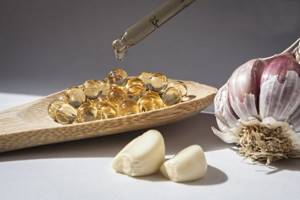
Garlic tincture
Ingredients:
- garlic – 400 g;
- vodka – 250 g.
Cooking method:
- Pass the garlic through a press or chop it in a garlic press. Pour vodka (or alcohol) and keep in a dark place for 10 days.
Mode of application:
Take on an empty stomach (it is better to add it to milk), half an hour before meals according to the following scheme:
First week
You need to start with two drops and increase the amount of tincture every day so that on the seventh day you take 17-20 drops.
Second week
20 drops three times a day 30 minutes before meals.
Third week
Gradually reduce the amount of tincture you use from 20 drops so that you end the seventh day with 2 drops.
This treatment regimen can be repeated once every three years.
Dry linden blossom (linden flour)
Cooking method:
- Grind linden flowers in a coffee grinder until it becomes flour.
Mode of application:
- Three times a day, a teaspoon. Drink with a glass of water.
Duration of treatment is 1 month. After a 14-day break, the course is repeated.

Healthy dessert
Ingredients (all in equal proportions):
- lemons;
- honey;
- dried apricots;
- raisin;
- walnuts.
Cooking method:
- Pass dried fruits through a meat grinder, pour in natural honey, leave for a day.
Mode of application:
- Eat a tablespoon of the sweet mixture half an hour before breakfast.
The healthy dessert must be stored in the refrigerator.
4% propolis tincture
Directions for use: dissolve 7 drops in 40 ml of water, take 3 times a day 40 minutes before meals. Course duration: 4 months.
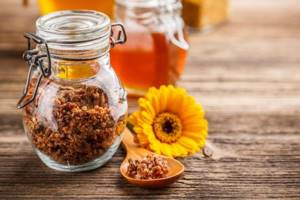
Celery
An excellent option for breakfast or afternoon snack during a cholesterol diet.
Cooking method:
- Place celery stalks in boiling water for 2-3 minutes. Cool, sprinkle with vegetable oil, sprinkle with sesame seeds and add a little honey.
Horseradish with sour cream
Ingredients:
- horseradish root;
- a glass of low-fat sour cream.
Cooking method:
- Grind the horseradish root, add sour cream.
Mode of application:
- 3-4 times a day along with meals.
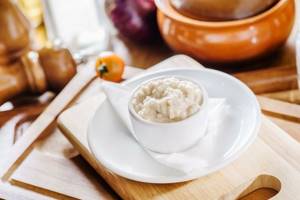
Flax-seed
Flax and flaxseed have proven themselves to be an excellent anti-sclerotic agent. You can take flaxseed oil, decoctions and tinctures, and also eat flaxseed.
Herbal decoctions
Decoctions of various herbs are also part of lipid-lowering therapy. Dandelion roots, alfalfa, licorice, corn silk, buckthorn, motherwort, mint, golden mustache, hawthorn and many others are suitable for this purpose.
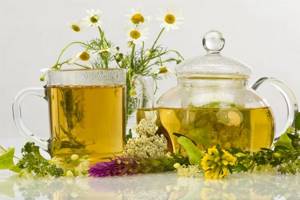
Menu for a week with a hypocholesterolemic diet
The menu for a week with high cholesterol levels should consist only of permitted foods, of which there are quite a lot, so creating a daily balanced diet will not require much effort.
Below is a sample menu based on which you can come up with your own meal plan.
Monday:
- breakfast - low-fat cottage cheese (150 grams), green or herbal tea, oatmeal;
- second breakfast - some berries or an apple;
- lunch - low-fat meat or vegetable soup, boiled chicken breast (100 grams), vegetable salad seasoned with a small amount of vegetable oil, a slice of rye black bread;
- afternoon snack - unsweetened yogurt or any fruit;
- dinner - two boiled egg whites, green beans with carrots (stewed or cooked in a double boiler).

Tuesday:
- breakfast - fruit salad, a glass of low-fat fermented milk product, a slice of whole grain bread;
- second breakfast - any fruit or fruit jelly without sugar;
- lunch - baked or steamed fish (150 grams), cabbage salad with carrots, seasoned with balsamic or soy sauce and a small amount of vegetable oil;
- afternoon snack - cheese with rye or whole grain bread and herbs;
- dinner - two stewed beef meatballs with stewed vegetables (peppers, cauliflower, carrots).
Wednesday:
- breakfast - buckwheat porridge and tomato or vegetable juice;
- second breakfast - baked apple with honey, black tea;
- lunch - pureed vegetable soup, a slice of bread with bran, salad with mushrooms (oyster mushrooms or champignons).
- afternoon snack - green tea and one marshmallow;
- dinner - stewed rabbit (250 grams) and Greek salad.
Thursday:
- breakfast - cheesecakes with fruit jam (4 pieces), apple and carrot salad with nuts, a glass of low-fat fermented milk product;
- second breakfast - rosehip decoction, dried fruits (5 prunes and the same amount of dried apricots);
- lunch - gazpacho, boiled veal (150 grams), a piece of gray or whole grain bread;
- afternoon snack - low-fat cottage cheese with raisins and unsweetened compote;
- dinner - durum wheat pasta and baked or steamed fish (150 grams).
Friday:
- breakfast - millet porridge with apple, rosehip decoction;
- second breakfast - any low-fat fermented milk product;
- lunch - seafood and olive salad, a glass of any unsweetened fruit juice;
- afternoon snack - some grapes;
- dinner - boiled beans with spices, tomato and cucumber salad, seasoned with a small amount of vegetable oil.
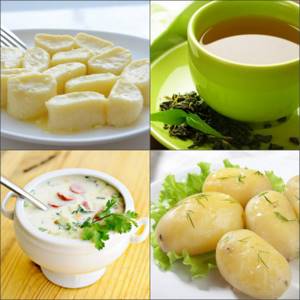
Saturday:
- breakfast - lazy dumplings, black or green tea;
- second breakfast - tomato with cheese;
- lunch - vegetable hash, a slice of bran or whole grain bread;
- afternoon snack - any two fruits;
- dinner - boiled potatoes, turkey, vegetable salad.
Sunday:
- breakfast - weak coffee with milk, oatmeal and one egg white;
- second breakfast - fruit jelly or fruit ice cream;
- lunch - low-fat chicken soup, boiled or baked veal (100 grams), radish salad;
- afternoon snack - orange or unsweetened yogurt;
- dinner - risotto with mushrooms or spaghetti in tomato sauce, boiled beet salad.
Juice therapy
In addition to special nutrition, nutritionists have also developed a method for reducing the overall level of fats in the blood by drinking juices according to a special scheme.
The duration of the course is 5 days. During this time, in the morning, on an empty stomach, you need to drink fresh juice (freshly squeezed juice).
First day: 70 ml celery juice and 130 ml carrot juice.
Second day: mix 70 ml of beet juice with 100 ml of carrot juice and 70 ml of cucumber juice.
Beetroot juice must be squeezed out 1.5-2 hours before consumption.
Third day: mix 70 ml apple juice and 70 ml celery juice with 130 ml fresh carrot juice.
Fourth day: add 70 ml of apple juice to 130 ml of carrot juice.
Fifth day: 130 ml orange juice.
Juice therapy can reduce TC by 10% and lose a little weight.
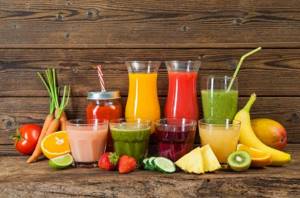
Recipes for a hypocholesterol diet
It is quite easy to diversify the menu during a hypocholesterol diet, since there are quite a lot of foods that are allowed to be consumed. For daily use, such popular dishes as: okroshka, only instead of sausage you can cut boiled chicken fillet or lean veal, vegetable stew with rabbit, risotto with mushrooms and vegetables, cheesecakes, seafood salad, gazpacho, pilaf with dried apricots and prunes and much more. other delicious dishes.
Syrniki
To prepare such a tasty and healthy dish you will need:
- low-fat cottage cheese - 300 grams;
- semolina - 2 tablespoons;
- flour - 4 tablespoons;
- egg white - 2 pieces;
- soda - 1 teaspoon.
Beat the whites with a small amount of sugar, add grated cottage cheese. Then add flour, soda and semolina to the mixture and stir until a homogeneous consistency is obtained. Spoon the resulting mixture onto a baking sheet lined with foil or parchment and cook in the oven at 180 degrees for 15 minutes.
Gazpacho

Gazpacho is a cold Spanish soup made from pureed raw vegetables. To prepare it you will need:
- large fleshy tomatoes - 3 pieces;
- cucumber - 1 piece;
- sweet bell pepper - 1 piece;
- white bread - 1 slice;
- garlic - 2 cloves;
- olive oil - 1 tablespoon;
- salt;
- spices;
- ice.
Place the tomatoes in boiling water for a few seconds to make it easier to remove the skin. Soak the bread in warm water. Peel the vegetables and place in a blender along with the bread. Grind everything until you obtain a homogeneous puree-like consistency. Place on plates, add olive oil and herbs. In summer, it is recommended to add a little ice to this soup.
Sweet pilaf
To prepare such an easy and tasty dish you will need:
- brown rice - 250 grams;
- dried apricots - 200 grams;
- carrots - 1 piece;
- prunes - 100 grams;
- apple - 1 piece.
Rice must be boiled before cooking. Cut the apple, carrots and dried fruits into small strips. It is advisable to pre-soak dried fruits for a few minutes. In a cauldron, fry chopped dried fruits, carrots and apples, add boiled rice, stir. Add water and simmer until it evaporates completely.
Reasons for the increase
Doctors say one of the main reasons for a high cholesterol index is an incorrect lifestyle, as well as non-compliance with dietary culture.
Many people have switched to eating processed foods, which has a negative impact on lipid metabolism and an increase in low molecular density lipoproteins.
In addition to unbalanced food intake, the following risk factors for increasing the cholesterol index can be noted:
- Genetic hereditary predisposition;
- Chronic degree of alcoholism;
- Lack of physical activity on the body - physical inactivity;
- Nicotine addiction;
- Excess weight is a pathology of obesity.
All these factors lead to the development of dangerous pathologies, which quite often lead to death.
In order to avoid such a fate, it is necessary to promptly diagnose the body for cholesterol, and if it increases, start with dietary adjustments.
Doctors prescribe a hypocholesterol diet.

Quite often, after applying this diet, the cholesterol index returns to standard levels.
Results of a hypocholesterol diet
Best materials of the month
- Coronaviruses: SARS-CoV-2 (COVID-19)
- Antibiotics for the prevention and treatment of COVID-19: how effective are they?
- The most common "office" diseases
- Does vodka kill coronavirus?
- How to stay alive on our roads?
This diet helps to significantly reduce and normalize cholesterol levels in the blood, and also helps improve the condition of blood vessels and the liver. But in order to completely normalize cholesterol levels, diet alone is not enough. It is recommended to take medications prescribed by a doctor, so before “settling” on such a diet, you should consult a cardiologist and nutritionist. The diet is very well balanced, so it can be used throughout life. Thus, having tried this method once and convinced of its effectiveness, you can make such nutrition a way of life. And as a positive addition to such a diet, there will be weight loss and maintaining it at normal levels for quite a long time. In addition to the low-cholesterol diet, it is very good to introduce sports into your daily routine and get rid of bad habits, such as smoking and alcohol. And then you will feel how much your life has changed for the better.
What is cholesterol and why is it needed?
Cholesterol is a fatty alcohol-containing substance that is a building block for all cell membranes in the body. Without cholesterol, many life processes cannot occur.
Cholesterol is necessary for the production of hormones and the functioning of endocrine organs.
Vitamin D is produced only with the assistance of cholesterol.
Reproductive function also depends on the synthesis of cholesterol molecules.
The synthesis of cholesterol molecules occurs in liver cells, and the body independently produces 80.0% of everything necessary for life. The remaining 20.0% of cholesterol enters the body through food.
Not always, cholesterol that comes with food brings benefits to the body; most often, these are low molecular weight lipoproteins, which are deposited on the inner lining of blood vessels, causing the development of such pathologies:
- The growth of plaques on the arteries and blockage of the lumen;
- Pathology atherosclerosis;
- Formation of blood clots - thrombosis;
- Acute coronary insufficiency;
- Unstable angina;
- Ischemia of the cardiac organ - heart attack;
- Hemorrhage of the cerebral arteries - stroke.

Cholesterol from food does not always benefit the body.
Advice for women
Dietary recipes for hypocholesterol nutrition should be as varied and tasty as possible. If you are pregnant or breastfeeding, you should stop dieting.
The most important tip: every day you should get the main components from food: proteins, fats and carbohydrates.
Food should be divided into several types, some should be consumed in the first half, some in the other. Fruits and vegetables should be preferred in the evening.
Who is it shown to?
Cholesterol levels rise gradually, the person is not aware of the presence of problems, since the symptoms begin to be taken for granted. Preventive examinations and tests play an important role in diagnosing the condition.
It is recommended to pay attention to timely examination in the following cases:
- weight gain;
- genetic predisposition (problem with cholesterol levels in close relatives)
- close relatives have a tendency to form blood clots;
- the occurrence of angina and arrhythmia;
- presence of diabetes;
- the occurrence of attacks of high blood pressure.


